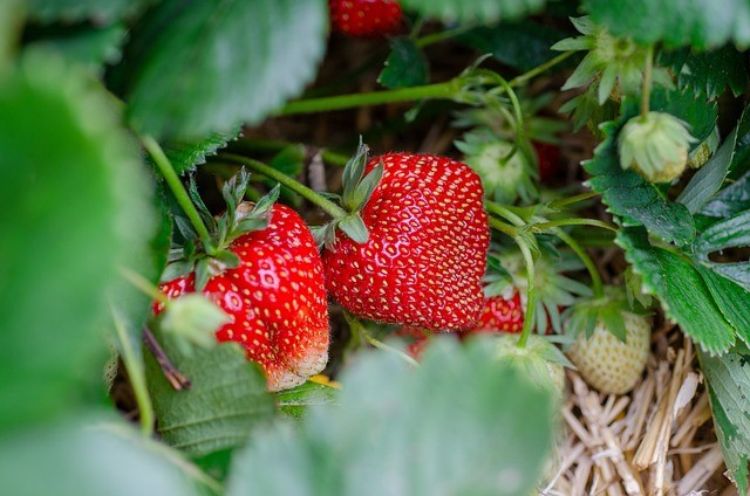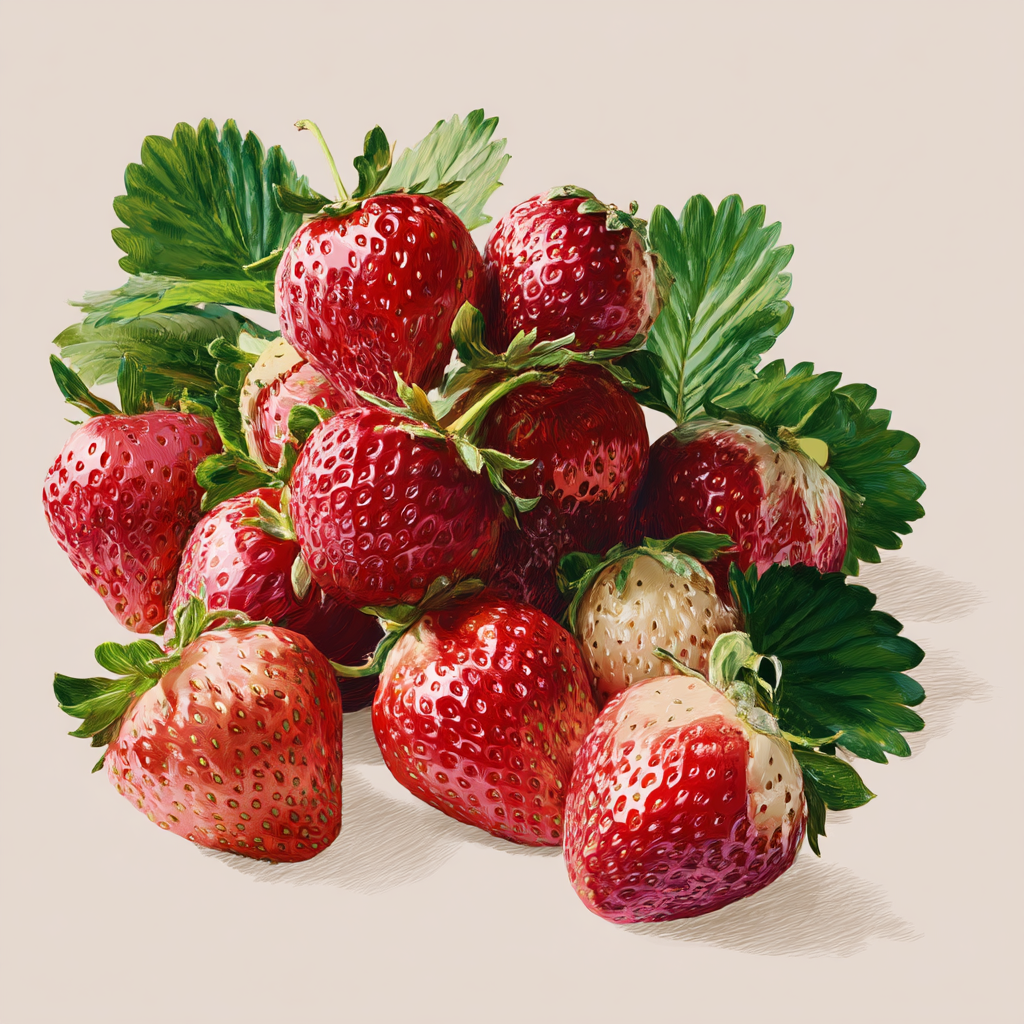Contents:
Common Names | Parts Usually Used | Plant(s) & Culture | Where Found | Medicinal Properties | Biochemical Information
Legends, Myths and Stories | Uses | Formulas or Dosages | Nutrient Content | How Sold | Warning | Resource Links
Scientific Names

- Fragaria ananassa (cultivated strawberry)
- Fragaria virginiana (wild Virginia strawberry)
- Fragaria chiloensis (beach strawberry)
- Rosaceae
- Rose family
Common Names
- Strawberry
- Virginia strawberry
- Beach strawberry
Parts Usually Used
The fruit, leaves, and roots
Back to Top

Description of Plant(s) and Culture
Strawberry is a low-growing perennial plant belonging to the rose family (Rosaceae). It has a basal rosette of three-part compound leaves with toothed edges. The plant produces white five-petaled flowers that develop into the familiar red, juicy fruits. Technically, what we call the strawberry fruit is actually an enlarged receptacle of the flower with the true fruits being the small seeds (achenes) on the outside. The plant reproduces through runners (stolons) that extend outward from the parent plant, creating new plants. Strawberries can be cultivated or wild, with cultivated varieties being a hybrid (Fragaria ananassa) developed in the 18th century from wild strawberry species native to North America and Chile.
Back to Top
Where Found
Wild strawberries are native to temperate regions of the Northern Hemisphere, including North America, Europe, and parts of Asia. They grow naturally in woodlands, grasslands, alongside trails, and in open meadows. Cultivated strawberries are grown worldwide, with major production in the United States, Spain, Turkey, Egypt, Mexico, and many other countries. They thrive in well-drained soil with full sun exposure and are often grown in home gardens, farms, and commercial operations.
Back to Top
Medicinal Properties
Strawberries possess numerous medicinal properties including antioxidant, anti-inflammatory, astringent, antimicrobial, diuretic, and anti-diarrheal effects. They contain compounds that may help regulate blood sugar levels and improve insulin sensitivity. The fruit and leaves also demonstrate cardioprotective properties by potentially lowering cholesterol levels, reducing triglycerides, and improving blood vessel function.
Research indicates that strawberries have neuroprotective qualities that may slow cognitive decline and reduce the risk of neurodegenerative conditions like Alzheimer’s disease. Studies also suggest potential anticancer properties, with certain compounds in strawberries showing the ability to inhibit cancer cell proliferation. Additionally, strawberries demonstrate benefits for joint health, with some evidence suggesting they may help reduce inflammation and pain in conditions like osteoarthritis.
Back to Top
Biochemical Information
Strawberries contain numerous bioactive compounds that contribute to their medicinal properties. The fruit is rich in vitamin C (ascorbic acid), which acts as an antioxidant and supports immune function. Strawberries are especially high in polyphenols, particularly anthocyanins (which give them their red color) and ellagitannins. Ellagitannins in strawberries break down into ellagic acid, which has demonstrated anticancer and anti-inflammatory properties in laboratory studies.
Other important compounds in strawberries include flavonoids (such as quercetin and kaempferol), phenolic acids, and various tannins. The leaves contain condensed tannins and ellagitannins that contribute to their astringent properties. Strawberries also contain folate, manganese, and various other vitamins and minerals that play important roles in human health.
Back to Top
Legends, Myths and Stories
Strawberries have been enjoyed by humans for thousands of years before cultivation began, with references dating back to ancient Roman literature. Native American legends often feature strawberries, including a Cherokee tale in which the first strawberry was created by the sun to reconcile the first man and woman after an argument.
In medieval Europe, strawberries were considered symbols of perfection and righteousness due to their color and shape. The fruit was often carved into the stonework of churches and cathedrals as a symbol of perfect righteousness. In some European folk traditions, pregnant women were advised to avoid strawberries for fear of their babies being born with strawberry-shaped birthmarks. Strawberries also featured in traditional medicine texts, with the Roman naturalist Pliny the Elder noting their use for treating melancholy, fainting, inflammations, and diseases of the blood.
Back to Top
Uses
Strawberries have a wide range of medicinal applications based on their nutritional and phytochemical properties:
For oral health, strawberry leaves and fruit can be used to care for teeth and gums. The astringent properties help reduce inflammation in swollen gums, while the fruit can help remove surface stains on teeth. A traditional practice involves rubbing the fruit directly on teeth to help remove discoloration.
For digestive issues, strawberry leaf tea has been used to treat diarrhea due to its astringent properties. The high fiber content in the fruit supports overall digestive health and regular bowel movements.
For skin care, cooled strawberry leaf tea can be applied to sunburned skin to soothe inflammation. The astringent properties of the leaves also make them useful for oily skin conditions.
Other traditional and modern uses include:
- Cardiovascular support through cholesterol and blood pressure regulation
- Blood sugar management for those with diabetes or insulin resistance
- Brain health support to protect against age-related cognitive decline
- Immune system boosting through high vitamin C content
- Anti-inflammatory support for conditions like arthritis
- Detoxification and liver support
- Diuretic effects to reduce water retention
- Treatment for fever through cooling properties
Formulas or Dosages
For strawberry leaf tea to treat diarrhea: Steep 1-2 teaspoons of dried leaves in 1 cup of hot water for 10-15 minutes. Drink 2-3 cups daily as needed.
For sunburn relief: Prepare a strong infusion of strawberry leaves (4 tablespoons of dried leaves in 2 cups of water), cool completely, then apply to affected areas with a soft cloth.
For heart health and diabetes management: Research suggests consuming 3-4 servings (approximately 1-2 cups) of fresh strawberries per week may provide benefits. In clinical studies, freeze-dried strawberry powder has been used at doses of 25-50 grams daily (equivalent to approximately 3-4 cups of fresh strawberries).
For oral health: Rub the crushed pulp of a fresh strawberry directly on teeth for 1-2 minutes to help remove surface stains, then rinse thoroughly with water.
Back to Top
Nutrient Content
According to nutritional data, a 1-cup (100g) serving of fresh strawberries contains:
- 32 calories
- 0.7 grams of protein
- 0.3 grams of fat
- 7.7 grams of carbohydrates
- 2 grams of fiber
- 4.9 grams of sugar
- 91% water
- 59 mg of vitamin C (98% of daily value)
- 19.8 μg of folate (5% DV)
- 0.4 mg of manganese (20% DV)
- 153 mg of potassium (4% DV)
- 16 mg of calcium (2% DV)
- 13 mg of magnesium (3% DV)
- 24 mg of phosphorus (3% DV)
- Significant amounts of anthocyanins, ellagitannins, and other polyphenols
How Sold
Strawberries and strawberry-derived products are available in various forms:
- Fresh fruit in grocery stores, farmers’ markets, and pick-your-own farms
- Frozen strawberries
- Dried strawberry fruit and powders
- Strawberry leaf tea (loose leaf or in tea bags)
- Freeze-dried strawberry powder supplements
- Strawberry extracts in liquid or capsule form
- Strawberry-infused skincare products including creams, masks, and cleansers
- Strawberry seed oil for cosmetic applications
Warning
While strawberries are generally safe for most people when consumed in normal food amounts, certain precautions should be considered:
Allergic reactions to strawberries are relatively common. Symptoms may include hives, itching, swelling of the lips and tongue, or more severe reactions. Those with known berry allergies or allergies to birch pollen may be more susceptible to strawberry allergies due to cross-reactivity.
People taking blood-thinning medications such as warfarin (Coumadin) should use medicinal amounts of strawberry with caution, as compounds in strawberries might slow blood clotting and increase the risk of bruising and bleeding. It’s advisable to stop using strawberry in medicinal amounts at least two weeks before scheduled surgery.
Strawberries may interact with certain medications that are transported by P-glycoprotein pumps in cells, potentially increasing the absorption and side effects of these drugs. If you’re taking prescription medications, consult with a healthcare provider before using strawberry products in medicinal amounts.
Back to Top
Resource Links
Fruit & Vegetable-Based Compound May Help Slow ALS and Dementia Progression
Futurity – Natural compound from fruits may slow ALS and dementia
University of Missouri – Mizzou researchers discover natural compound may slow ALS and dementia
The Practical Herbalist – Strawberry: Nature’s Toothpaste
WebMD – Strawberry – Uses, Side Effects, and More
WebMD – Health Benefits of Strawberries
Healthline – Strawberries 101: Nutrition Facts and Health Benefits
ScienceDirect – The strawberry: Composition, nutritional quality, and impact on human health
Cleveland Clinic – All the Reasons You Should Eat Strawberries
ALASKA’S WILDERNESS MEDICINES – Strawberry
